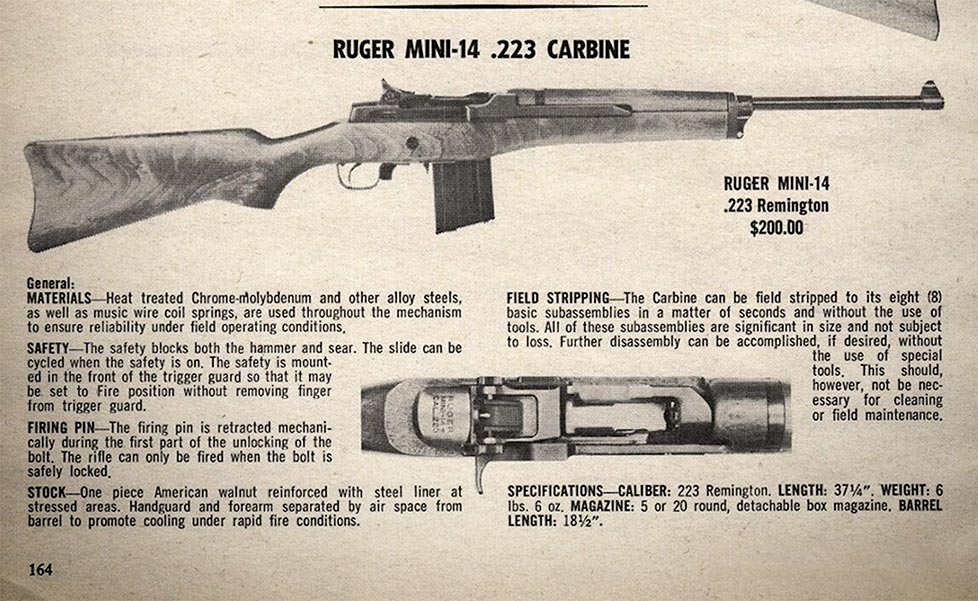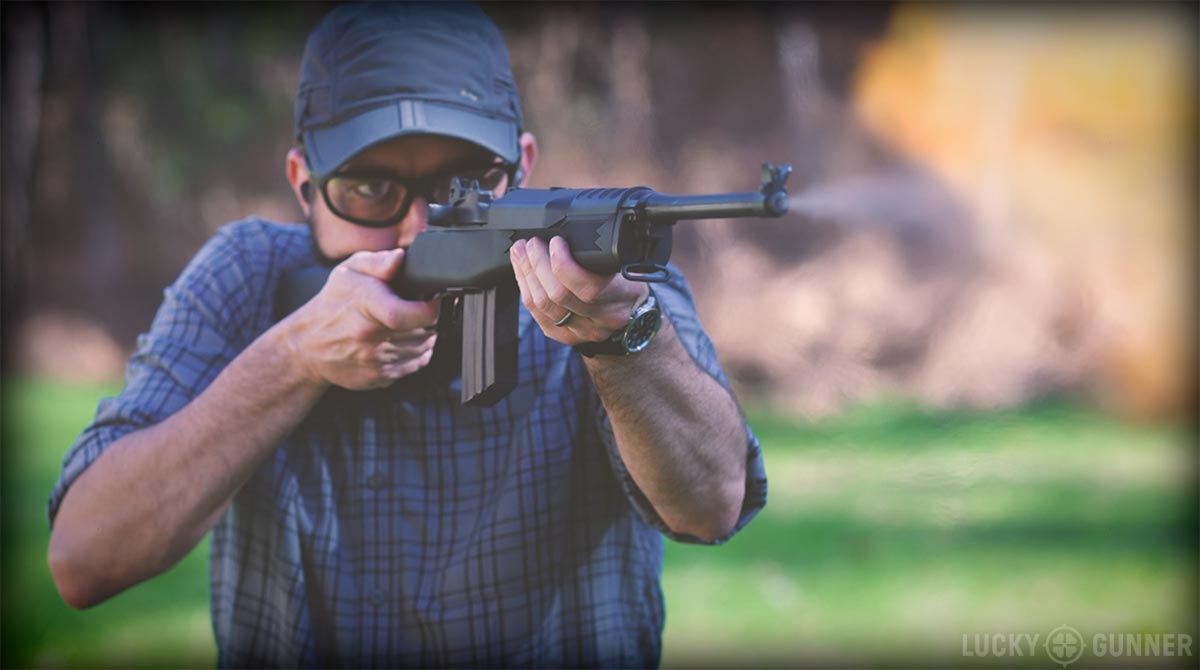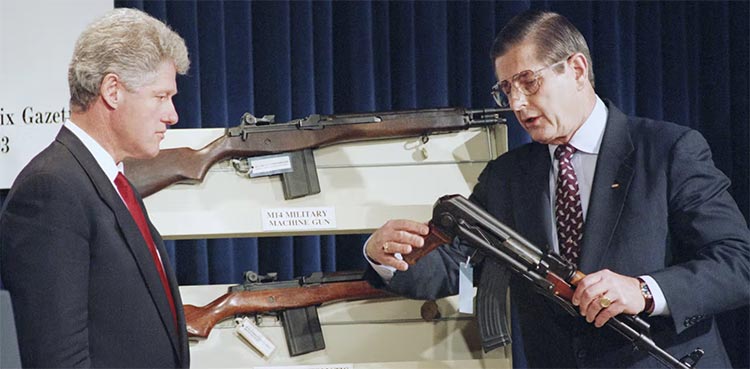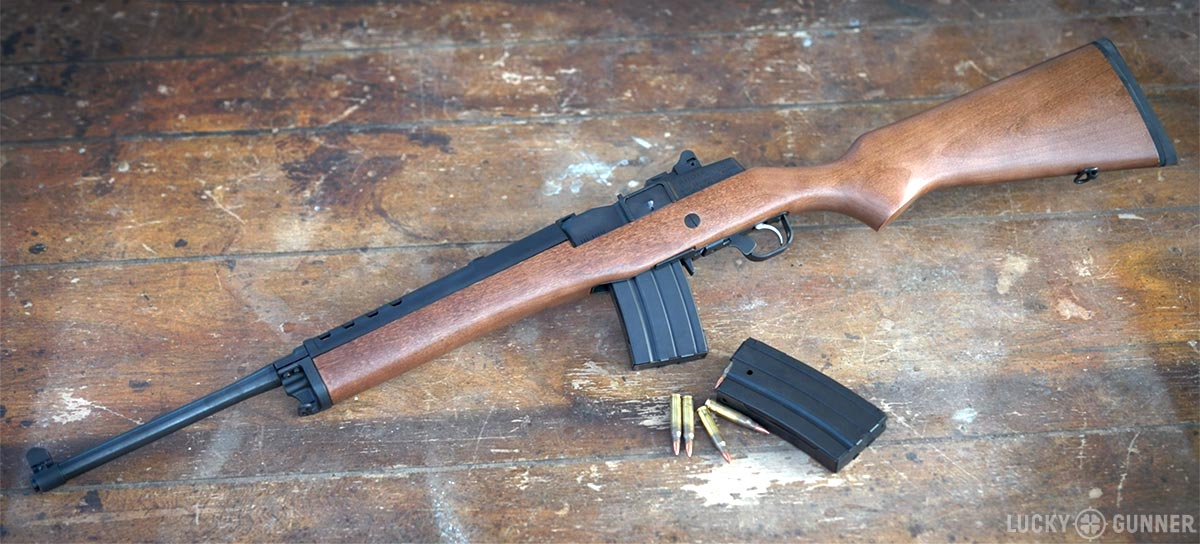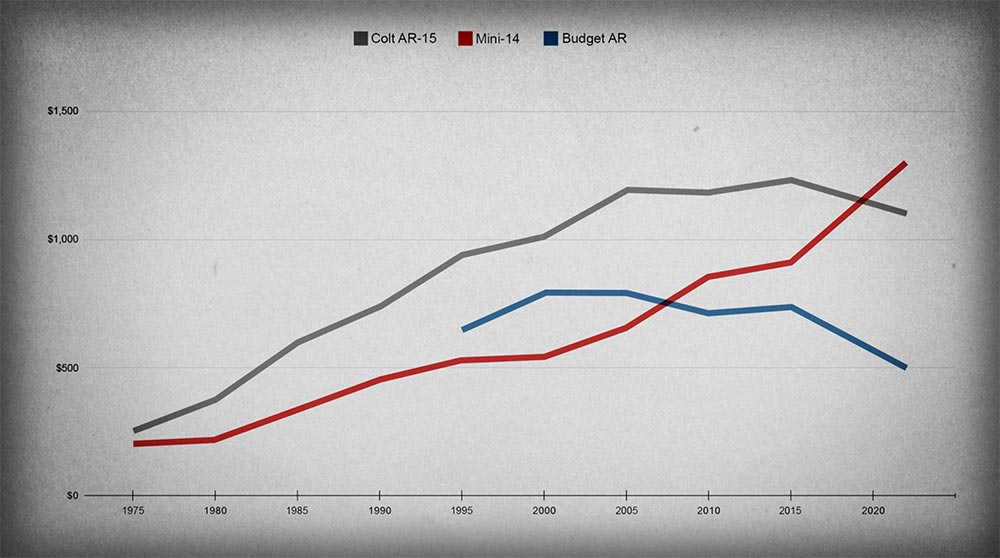For at least couple of decades, the Ruger Mini-14 was America’s favorite semi-automatic rifle. But that time has passed. If you’re seen with one today, The Internet is likely to label you either a Fudd or a snowflake.
In spite of that, the Mini-14 is still in production today, and well loved by many shooters. But… why? In the first installment of a two-part series, we’re looking at how the Mini-14 got to where it is today.
Details are in the video below, or scroll down to read the full transcript.
When the Ruger Mini-14 showed up 1974, there really wasn’t anything else quite like it available. It filled an important gap in the firearms market and quickly became one of the best selling centerfire rifles in the country.
Now, almost 50 years later, the preferences of the average gun buyer have drastically changed, but the Mini-14 is practically the same as it ever was. The demise of this rifle has been predicted many times in recent years. But against all odds, Ruger is still making them and shooters are still buying them. They’re not as popular as they once were, but at least for right now, the Mini-14 is not dead yet.
To understand how this is possible, it might help to look at what made the Mini-14 such a big success to begin with. So let’s go back in time… back to 1959.
From M14 to Mini-14
Following WWII, the US military went through the long, tedious process of selecting a new service rifle. Ideally, this new rifle would replace the battery of small arms they were currently using, including the M1 Garand, M1 Carbine, M1918 BAR, and the M3 Grease Gun.
They eventually settled on the M14 — essentially a magazine-fed Garand chambered for 7.62×51. Unfortunately, it turned out not to be the ideal solution the US Military hoped for. It wasn’t a bad rifle. But for its intended role, the 7.62 NATO cartridge was too powerful, the gun was too heavy, and too expensive to produce. After only five years, it was replaced with the M16.
By the mid-70s, commercial versions of the M14 were available to civilians. But they were primarily used for long range competition. They were (and still are) popular in High Power rifle matches. It didn’t really fit the needs of the average shooter for the same reasons it failed in the military. It was too heavy, too expensive, and just too much gun for most purposes.
But the M14 still had some appealing features. It had a traditional wood stock with the Garand-style action that American shooters were accustomed to. And it had detachable magazines with double-digit capacity – something very uncommon among civilian firearms at the time. The major exception was the WWII surplus M1 Carbine – also very well-liked, although a little under-powered. If a semi-auto M14 could somehow be made smaller and cheaper and chambered for a round with a bit more practical usefulness than the .30 Carbine, it could be massively successful.
And that’s essentially what Bill Ruger had in mind when he got his design team to start working on a scaled-down M14 based on the .223 Remington cartridge. Within five years, Ruger was showing off the first pre-production samples of the new Mini-14 rifle. Mass production started soon after and by 1974, dealers were stocking a gun that turned out to be immediately popular with customers.
Familiar Features
The original models bore a strong resemblance to the M1 Carbine. They were slightly heavier, but still very light at just 6.4 pounds. They had an 18.5-inch barrel, aperture-style iron sights, and they fed from five or 20-round detachable magazines.
The rotating bolt design looked like it came straight from an M1 Garand or M1 Carbine. Ruger also borrowed the trigger guard style manual safety from the Garand. All of this would have looked and felt very familiar to shooters in the 1970s. The only thing that was really new and different was the .223 cartridge, which was not yet widely used outside of the military.
The Everyman’s Defensive Rifle
I have here a copy of the Gun Digest Annual from 1973. Every year, they print a catalog of all the firearms in current production. In this edition, the autoloading centerfire rifle section is just these two pages. Eleven entries. Three of them are commercial copies of the M1 Carbine (which means there’s a good chance they didn’t work). There’s a weird little 9mm carbine up here. There’s the Colt AR-15 Sporter. And the rest are very traditional-style hunting rifles.
This is what I mean by there being a huge gap in the market. Practically speaking, the AR-15 was similar to the Mini-14 – both rifles could do essentially the same thing. But the Colt was expensive – about $1600 when you adjust for inflation. It had plastic furniture and a bizarre appearance. It also had a really poor reputation. Beuracratic incompetence had caused a bunch of problems with the early M16s in Vietnam. It was decades before the commercial version of that rifle was widely accepted by civilian shooters.
And I’m no historian or sociologist, but I think this period was probably a turning point for American gun owners just like it was for American culture in general. Think about what else was going on at the time. We were still in Vietnam, which nobody was happy about. Nixon resigned in ‘74. The people’s trust in the US government was at an all time low. We had a lot of social unrest and the constant threat of nuclear war with the Soviets.
It would be very understandable if some Americans – maybe for the first time – started thinking they might need to take more responsibility for their own security. Even though Ruger marketed the Mini-14 as a law enforcement rifle, on the civilian side, all the advertising was exclusively about hunting. But it didn’t take long for shooters to notice that it could also be ideal for protecting their home and family if society really started falling apart. And its traditional appearance meant you could buy one without people thinking you were trying to be some kind of survivalist commando.
In a 1974 review, Col. Jeff Cooper wrote, “it will do everything the M-16 will do, but better… It is light, handy, quick, and gentle, and it shoots practically forever without reloading. And at defensive ranges – across the yard – it strikes a wicked blow. A Mini-14 over the kitchen door would be well worth its price – in peace of mind.”
The price tag on the Mini-14 started out at 200 bucks and that’s where it stayed for several years. That’s close to $1300 today, so it was not a cheap rifle. But then, throughout all the crazy-high inflation of the late 70s, Ruger raised the price very little. By 1980, a Mini cost the equivalent of $830 – a little more than half of what an AR cost at the time.
Mini-14 Variants
The Mini-14’s success continued into the 1980s, including several new variants. They made a stainless steel mode and a version chambered for 7.62×39 called the Mini-30 – both of those are still around today. The Ranch Rifle was basically a Mini-14 that’s machined for scope rings. That eventually became a standard feature on all Minis.
At some point, Ruger added 10 and 30-round magazines to the original five and 20-rounders. The 20 and 30-round factory mags were tough to find outside of law enforcement dealers. It sounds like they were available on the commercial market, they just weren’t always common.
Ruger did make some variants of the rifle itself that were totally restricted to law enforcement and military sales. The Mini-14 GB had a flash hider, bayonet lug, and an optional folding stock with a pistol grip. The AC-556 was a select-fire version with full auto and 3-round burst modes. But many of the rifles that were picked up by police and foreign militaries were no different than the commercial Mini-14, partly because those guns had a lower social profile. They were less likely to freak out the average citizen than a more modern style design.
The Mini-14 Goes to Washington
And now, we have to talk about 1989. I hate to get into anything political, but this is an important part of the Mini-14’s history, so here we go. In the late 80s, politicians from both major parties were making a lot of noise about major gun control legislation. George Bush Sr. even talked about a complete ban on semi-automatics. The gun industry was already going through a major financial slump. A semi-auto ban would only make matters worse.
So Bill Ruger thought he could divert attention away from an outright ban if he threw the politicians a different bone to chew on. In 1989, he wrote Congress a letter that basically said “Instead of going to all the trouble of trying to codify what is and isn’t an assault rifle, why don’t you just ban magazines that hold more than 15 rounds?” Around the same time, Ruger completely restricted sales of 20 and 30-round Mini-14 magazines to law enforcement only.
Maybe Ruger was just trying to save his business, but needless to say, a lot of gun owners felt like this was a blatant betrayal. There were boycotts and a lot of angry letters. But the Mini-14 continued to be a big seller. Five years later, Bill Clinton signed the Assault Weapons Ban into law. It came with a 10-year expiration date and it banned the sale of new rifles with certain cosmetic features like flash hiders and folding stocks. It also came with a magazine ban, but instead of the 15 rounds Ruger suggested, you couldn’t buy new mags with a capacity greater than ten.
Well, the Mini-14 didn’t have any of the forbidden features listed in the ban. In fact, it was on the list of guns specifically exempted from the ban. A lot of other companies had to stop production and design modified versions of their rifles that would comply with the new rules. Meanwhile, the Mini-14 on the shelf at the gun shop was the same as it had always been.
The Mini-14’s Known Issues
Despite whether it was a good seller, the gun was not without problems. And by this time, they were well known in the shooting world.
Since the 20 and 30-round magazines were so hard to find, a number of third party companies stepped in to fill the gap. But those magazines didn’t always work very well. So the gun itself developed a reputation for being unreliable.
Ruger was stingy about sending out spare parts. If anything went wrong with a Mini-14, it had to be sent back to the factory. The action was really hard on scopes and scope rings. The safety inside the trigger guard is not in the most safe position.
But the most common complaint by far was accuracy. In the 70s, a rifle that could shoot 3-5 MOA was considered completely acceptable for a practical field rifle like the Mini-14. By the late 90s, shooters were expecting tighter groups, even with semi-autos. That’s not something the Mini-14 could keep up with.
The Mini-14 in the 21st Century
In the 2000s, a bunch of things happened in quick succession that all had an impact on the Mini-14. First, in 2000, Bill Ruger Sr. retired and handed over the company to his son. He passed away two years later.
In 2004, Congress did not renew the Assault Weapons Ban, so it expired. However, Ruger still restricted sales of the higher capacity Mini-14 mags to law enforcement only.
In 2005, Ruger made some major improvements to the Mini-14 design, resulting in more accurate rifles. The post ‘05 models have a serial number beginning with 58 and a distinctive tapered barrel.
In 2006, Bill Ruger Jr. retired. From then on, no one from the Ruger family held any kind of official influence on the company.
The new leadership at Ruger made a commitment to serve more defense-minded customers. That included, in 2008, the return of 20-round Mini-14 mags for everyone.
The Rise of the AR
Ruger, as a whole, has thrived under the new leadership, but it’s hard to say the same thing for the Mini-14 in particular. The gun industry changed dramatically between the mid 90s and the late 2000s. AR-15s were not just Colts anymore and they were no longer considered unreliable or obscure. High demand for black rifles drove competition. That competition drove down prices. The next thing you know, the Mini-14 no longer stood out as an affordable alternative to the AR.
Even just ten years ago, I remember often hearing people say, “A Mini-14 is okay if you can’t afford a decent AR.” But now, nobody’s really even saying that.
Let’s take a look at the historical price difference between a basic Mini-14 and an entry-level Colt AR.
Prices of both have risen with inflation over the years, but that price gap has narrowed to nothing, and today, the MSRP of a new Mini-14 is actually a couple hundred dollars more than a basic Colt M4.
Now let’s throw in some budget ARs in there. Those started popping up around the mid-90s, and at first, they weren’t all that good. But that changed over time. By 2015, you could get a Smith & Wesson M&P-15 Sport – a very solid rifle, for $170 less than a Mini-14. And now today, you can get two Palmetto State ARs for less than one Mini.
And it’s not just an issue of the cost of the guns. Basic 30-round AR mags are half the price of Ruger factory 20-round mags. And of course, ARs have normalized the flat top upper and picatinny rails everywhere. An entire industry has emerged around accessorizing and personalizing ARs and other modern rifles.
The Mini-14 did not get invited to that party. For a lot of shooters today, the Mini is starting to look – not just dated but completely obsolete.
So why is the Mini-14 still around? Apparently somebody’s buying them, even at today’s prices. What can a Mini do that a scary black rifle can’t do? That’s what we’re going to look at in Part 2. I hope you guys enjoyed Part 1. Until next time, be sure to get all your ammo from us with lightning fast shipping at LuckyGunner.com.
The post Why Won’t the Ruger Mini-14 Just Die? [Part 1] appeared first on Lucky Gunner Lounge.



